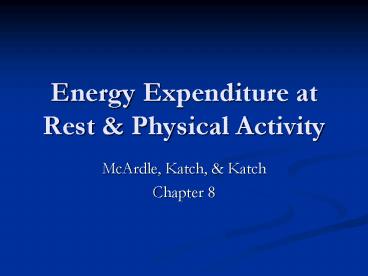Energy Expenditure at Rest - PowerPoint PPT Presentation
1 / 20
Title:
Energy Expenditure at Rest
Description:
... 40, average values BMR are 38 kcal/m2 per hour for men and 36 kcal/m2 for women. ... becomes less economical and relationship curves in upward direction. ... – PowerPoint PPT presentation
Number of Views:538
Avg rating:3.0/5.0
Title: Energy Expenditure at Rest
1
Energy Expenditure at Rest Physical Activity
- McArdle, Katch, Katch
- Chapter 8
2
Energy Expenditure at Rest
- Basal Metabolic Rate
- BMR is rate of energy expenditure fasted, rested
and supine conditions in thermoneutral
environment - Resting metabolic rate (RMR) is rate of energy
expenditure when at rest but not basal - BMR proportional to BSA, after age 20 ? 2 3
per decade in women and men, respectively - When RMR expressed per unit LBM, no difference
- BMR represents largest fraction of TEE in
sedentary
3
Energy Expenditure at Rest
- Influence of Body Size
- Differences in body size usually expressed in
terms of body surface area (BSA). - From 20-40, average values BMR are 38 kcal/m2 per
hour for men and 36 kcal/m2 for women. - Lower BMR in women can be attributed to womans
larger percent body fat smaller muscle mass.
4
Energy Expenditure at Rest
- Estimate Resting Daily Energy Expenditure
- Estimate kcal expenditure during rest by
multiplying ones surface area from nomogram by
appropriate kcal expenditure/m2 per hour by 24
hrs. - Also possible to use Harris Bennedict formulas.
- Estimated values w/i 5 measured values.
5
Energy Expenditure at Rest
- Factors Affecting Total Daily Energy Expenditure
- Physical Activity 15-30 of TDEE
- Dietary Induced Thermogenesis
- Thermic effect from processes of digesting,
absorbing, assimilating nutrients. - Thermogenesis reaches maximum w/i 1 hr post
- Thermogenesis can vary 10-35 of ingested food
energy
6
Energy Expenditure at Rest
- Factors affecting Total Daily Energy Expenditure
- Climate.
- Pregnancy.
7
Energy Expenditure in Physical Activity
- Expression of Energy Expenditure
- Total (gross) Resting energy expenditure (REE)
Net energy expenditure of the activity per se. - Recovery energy included in Total exercise
energy recovery energy. - Measure VO2 during an activity and recovery
multiplied by 5 kcal per liter yields gross
energy expenditure.
8
Energy Expenditure in Physical Activity
- Energy expended during weight-bearing activities
increases proportional to body mass. - Energy expended during non-weight-bearing
activities has little relationship to body mass.
9
Energy Expenditure in Physical Activity
- Average daily Total Energy Expenditure estimated
to be 2900 3000 kCal for males, and 2200 kCal
for females 15-50 y.o.a. - Great variability exists and largely determined
by ones physical activity.
10
Energy Expenditure in Physical Activity
- Classification of Work Factors
- Duration (min) and Intensity (VO2 kCal)
- A MET is a measure of activity intensity
represents an average persons resting metabolism
or VO2
11
Energy Expenditure in Physical Activity
- Classification of Work
- MET 3.5 mL O2 ? kg-1 ? min-1, 1 kCal ? kg-1 ?
hr-1 - Intensity of Work often related to Heart Rate
because of linear relationship to oxygen uptake.
12
Economy Efficiency of Energy Expenditure
- Mechanical Efficiency Work Output Energy
Input (expenditure). - Work Output Force x Distance
- kg ? m or ft ? lb.
- Three efficiency terms
- Gross
- Net
- Delta
13
Economy Efficiency of Energy Expenditure
- Gross efficiency uses total oxygen uptake.
- Work Output
- Energy Expended
- Net efficiency subtracts resting VO2 from total.
- Work Output
- Energy Expended Above Rest
- Delta efficiency computes relative energy cost of
performing an additional increment of work.
14
Energy Expenditure during Walking, Running, and
Swimming
- Economy is relationship between
- Energy output
- Energy input
- Greater economy requires less oxygen uptake to
perform a task. - Training adjustment that improves economy
directly relates to improved exercise performance.
15
Energy Expenditure during Walking, Running, and
Swimming
- Energy Expenditure during Walking
- Relationship between walking speed and oxygen
uptake essentially linear between speeds of 3.0
and 5.0 kilometers per hour (1.9 to 3.1 mph). - At faster speeds, walking becomes less economical
and relationship curves in upward direction.
16
Energy Expenditure during Walking, Running, and
Swimming
- Walking on snow and sand requires about twice the
energy expenditure of walking on hard surfaces. - Energy cost is proportionally larger for larger
people. - Hand-held weights increases energy cost of
walking but may disproportionately elevate
systolic blood pressure.
17
Energy Expenditure during Running
- More economical to discontinue walking and begin
to run or jog at speeds gt 6.5 kmh (4 mph). - Net energy cost of running a given distance is
independent of running speed. - Lengthening stride above the optimum length (and
reducing stride frequency) increases VO2 more
than shortening below optimum (and increasing
stride frequency). - Cost of running into headwind significantly
greater than the reduction with tailwind.
18
Energy Expenditure during Swimming
- Energy expenditure to swim a given distance is
about 4 times greater than to run same distance. - Energy must be expended to maintain buoyancy
while generating horizontal motion and to
overcome drag forces. - Total drag consists of
- Wave drag
- Skin friction drag
- Viscous pressure drag
19
Energy Expenditure during Swimming
- Elite swimmers expend fewer calories to swim a
given stroke at any velocity. - Women swim a given distance at lower energy cost
than men because of greater buoyancy.
20
Illustration Reference
- McArdle, William D., Frank I. Katch, and Victor
L. Katch. 2000. Essentials of Exercise
Physiology 2nd ed. Image Collection. Lippincott
Williams Wilkins.































